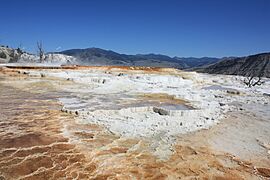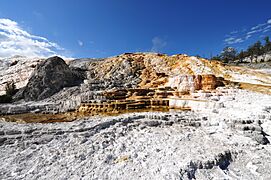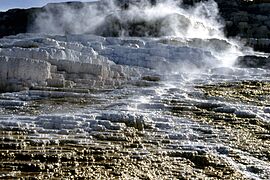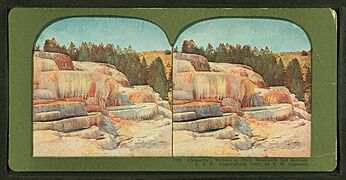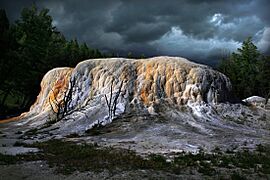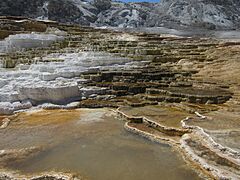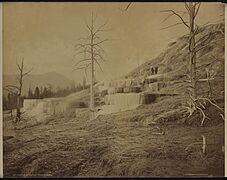Mammoth Hot Springs facts for kids
Quick facts for kids Mammoth Hot Springs |
|
|---|---|
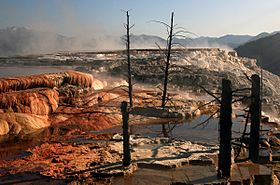
Dead Trees at Mammoth Hot Springs
|
|
| Location | Mammoth Hot Springs, Yellowstone National Park, Park County, Wyoming |
| Coordinates | 44°58′01″N 110°42′44″W / 44.96694°N 110.71222°W |
| Elevation | 6,735 feet (2,053 m) |
| Type | Hot spring complex |
Mammoth Hot Springs is a unique area in Yellowstone National Park. It's known for its many hot springs that create amazing terraces. These terraces are made of a rock called travertine.
This special place was formed over thousands of years. Hot water from underground brings a mineral called calcium carbonate to the surface. This mineral is like a natural cement. When the hot water cools, the calcium carbonate is left behind, slowly building up the beautiful terraces. Over two tons of this mineral flow into Mammoth every day!
How the Springs Work
The hot water for Mammoth Hot Springs comes from the Norris Geyser Basin. It travels underground through a crack in the Earth called a fault line. This fault line runs through limestone rock. The limestone is the source of the calcium carbonate that builds the terraces.
The water cools slightly as it travels, usually reaching the surface at about 170 °F (80 °C). Tiny living things called algae grow in the warm pools. They give the travertine terraces their amazing colors, like brown, orange, red, and green.
Changing Terraces
The hot springs at Mammoth are always changing. The way the water flows can vary a lot, sometimes over many years, and sometimes in just a few days. Terrace Mountain at Mammoth Hot Springs is the biggest place in the world where this kind of mineral deposit happens.
One of the most famous parts is the Minerva Terrace. It's a series of beautiful travertine steps. However, because of small earthquakes that happened around August 2014, the spring's water path shifted. This made the Minerva Terraces dry.
The Mammoth Terraces stretch from the hillside all the way down to a place called Boiling River. Even the Mammoth Hotel and the old Fort Yellowstone are built on an ancient terrace formation called Hotel Terrace. When they started building in 1891, some people worried the ground might not be strong enough. You can still see some large holes, called sinkholes, in the area today. This whole area has been active with hot springs for thousands of years.
Clues from the Ice Age
The Mammoth area also shows many signs of the Pinedale Glaciation, which was a time when glaciers covered much of the land. The top of Terrace Mountain is covered with glacial till. This shows that the travertine formations there are older than the end of the Pinedale Glaciation.
You can also see several thermal kames, which are hills made of sand and gravel left by melting glaciers. Capitol Hill and Dude Hill are examples of these in the Mammoth Village area. There are also signs of old stream beds from the edge of the ice, like in the small valleys where Floating Island Lake and Phantom Lake are found. In Gardner Canyon, you can see old river gravel covered by unsorted glacial till, which is a mix of rocks and dirt left by glaciers.
Gallery
-
Crystallized calcium carbonate terraces
-
Cleopatra's Terrace Stereo card by T.W. Ingersoll
See also


